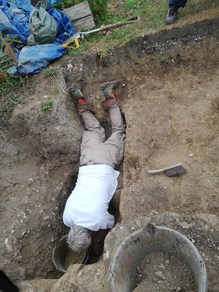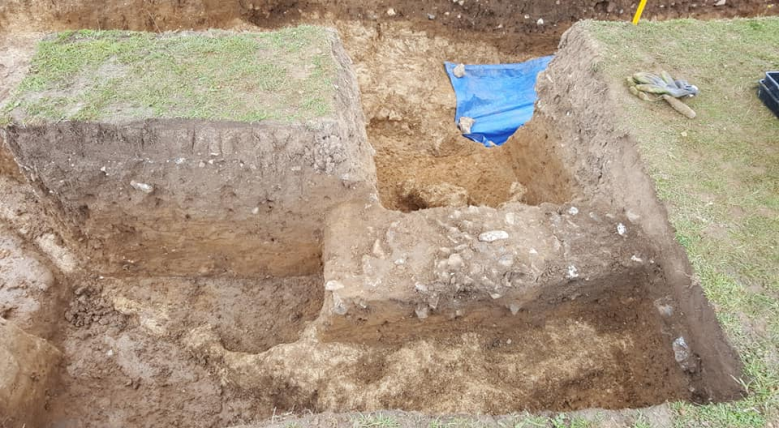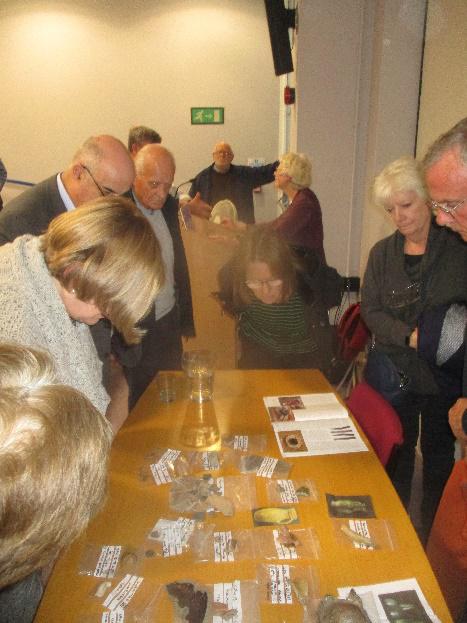Connie began with saying she was honoured to give this lecture as it was Con that first introduced her to archaeology way back in 1986 when she took one of his courses, and she has not looked back since - hence her long list of WAS titles.
Connie introduced the site, an area of land currently in use as horse paddocks just south of the A27, opposite Sompting Church and Sompting Abbotts. The project started when WAS were asked in 2017 to investigate the remains of a small flint building in one of the paddocks that was only meant to be a couple of days work…..
Connie introduced the site, an area of land currently in use as horse paddocks just south of the A27, opposite Sompting Church and Sompting Abbotts. The project started when WAS were asked in 2017 to investigate the remains of a small flint building in one of the paddocks that was only meant to be a couple of days work…..
The flint wall that started it all
Showing a bird’s eye image that was taken from a members drone, Connie talked through the site history. From the church - built in the 10th century - to the current Tristram family landowners owning the land since 1879. In 1936 the first South of England show was held there and in 1960 it hosted the Donkey Derby. A 1627 survey documented a Malting House on the site, 1772 Map shows the area as Malthouse Barn Field, Malthouse Field and Malthouse Close, 1896 map shows a pond and line of trees and the 1936 South of England show map shows the excavation area as close to the entrance, empties yard and rabbit stand.
The coast had been extremely close to the site but from the 13th century longshore drift led to the silting up of the local coastline and by the 18th century the land was being farmed. Connie added that a bonus to the work at Malthouse field had been the opportunity for WAS to fieldwalk an area further south of the site as part of the EPIC project which had recently dug a new channel for the local watercourse, exposing potentially prehistoric soil layers and worked flint. Members from WAS had found plenty including a broken Barbed and tanged arrowhead, microliths and a knapping site.
Summarising what had been found to date, Connie discussed the structure under the tree which had substantial walls and floor tiles. It could have held water but no drain was located. A pathway leading to it had oyster shell and clay pipe in it. A flint wall running east- west abuts the rectangular building and could be part of an earlier structure. A north-south flint wall contained a chalk block structure that revealed a well. On John Mill’s advice the 2019 excavations targeted the well cut which could date its construction. A clay with flints layer was discovered adjacent to the well cut, potentially deposited at the end of the last ice age and containing worked flint. When it became too deep to excavate the well cut further, an auger sample took the excavation to a total depth of 3.6 meters and revealed medieval pottery and struck flint.
The coast had been extremely close to the site but from the 13th century longshore drift led to the silting up of the local coastline and by the 18th century the land was being farmed. Connie added that a bonus to the work at Malthouse field had been the opportunity for WAS to fieldwalk an area further south of the site as part of the EPIC project which had recently dug a new channel for the local watercourse, exposing potentially prehistoric soil layers and worked flint. Members from WAS had found plenty including a broken Barbed and tanged arrowhead, microliths and a knapping site.
Summarising what had been found to date, Connie discussed the structure under the tree which had substantial walls and floor tiles. It could have held water but no drain was located. A pathway leading to it had oyster shell and clay pipe in it. A flint wall running east- west abuts the rectangular building and could be part of an earlier structure. A north-south flint wall contained a chalk block structure that revealed a well. On John Mill’s advice the 2019 excavations targeted the well cut which could date its construction. A clay with flints layer was discovered adjacent to the well cut, potentially deposited at the end of the last ice age and containing worked flint. When it became too deep to excavate the well cut further, an auger sample took the excavation to a total depth of 3.6 meters and revealed medieval pottery and struck flint.
The well cut: the depths members had to sink to
A compact ‘yard like’ surface was located below the north-south flint wall, and features that could be postholes were identified running along the middle of the building complex. The features are comparable with other known excavated Malthouse sites. A pit was also discovered that contained medieval pottery, oyster shell and worked flint, possibly evidence of an earlier occupation. Gordon Hayden then made a guest appearance via a video Connie showed from 2018 where he discussed layers of burning located within one of the trenches.
The 2019 excavations had only just finished so results are still being analysed, but trench targets had been established through Geophysical surveys in the spring. One survey had identified features in other paddocks. One was natural geology but the other (Trench 10) contained a modern water pipe (probably associated with the 1936 show), a degraded chalk surface which is found across the site which had features dug into it, a potentially military-cut trench, Romano-British pottery and a medieval pit containing Saxo-Norman pot sherds.
The 2019 excavations had only just finished so results are still being analysed, but trench targets had been established through Geophysical surveys in the spring. One survey had identified features in other paddocks. One was natural geology but the other (Trench 10) contained a modern water pipe (probably associated with the 1936 show), a degraded chalk surface which is found across the site which had features dug into it, a potentially military-cut trench, Romano-British pottery and a medieval pit containing Saxo-Norman pot sherds.
The enigma that was Trench 10
Building materials from across the site include substantial amount of flint, chalk, brick and evidence of wattle and daub. A piece of Caen stone from a mullion window was also discovered which contained a VV (Virgin of Virgins) apotropaic mark, possibly reused from another site. Finds include Prehistoric, Romano-British, medieval and later pottery, two 16th century Nuremberg Jettons and a French clay pipe stem (Connie likes to think it is evidence of smuggling). A piece of Bronze Age pottery contained a thumb print and some of the medieval pottery could be from Binsted.
More modern finds include glass, a powder compact, a key for a Hornby ‘0’ gauge toy train and a tube of Gleam toothpaste.
The flint finds indicate temporary hunting and farming but not permanent settlement.
Connie finished by revealing that a recent Tristram family document had come to light from 1758 showing another building on the site which could line up with one of the as yet unexcavated geophysical anomalies, possibly evidence of an earlier building. That’s for next year….to be continued ………
More modern finds include glass, a powder compact, a key for a Hornby ‘0’ gauge toy train and a tube of Gleam toothpaste.
The flint finds indicate temporary hunting and farming but not permanent settlement.
Connie finished by revealing that a recent Tristram family document had come to light from 1758 showing another building on the site which could line up with one of the as yet unexcavated geophysical anomalies, possibly evidence of an earlier building. That’s for next year….to be continued ………
Some of the finds
Vicky Lillywhite





